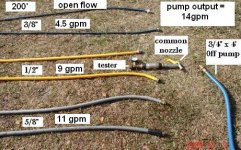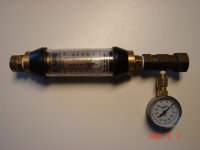taselton2
Softwashing Instructor/Moderator
I ran some tests last weekend on my pump with three different diameter hoses to see just what I could get at the end of 200'. The tests were done to maximize my efficiency and not for starting up more "hose wars". The pump pulled water from a supply tank and was attached to each line via a 3/4" x 4' supply hose coming directly out of the pump. The pump open flowed 14 gpms and had a "static" pressure of 150psi. Some hoses have different liners that flow with less resistance, but these hoses were all that I had. The picture below shows what each hose "open flowed" (no nozzle) at 200'. I did test the flow/psi with different nozzles and the higher flowing lines produced more psi every time. As you constrict the flow you generate the psi, more flow = more psi as long as you have good pressure output at the pump. I made up a nice chart, but it got all messed up when I previewed it. Pumps are different, but the flow capabilities of hoses are what they are. The longer you go the larger you need to get max out of it, the same is true with electricity. I am in the fire service and this is all common to me since I drive and pump fire trucks (10yrs) when I'm not washing roofs and houses. When we need to go a good distance we lay the 5" lines.



